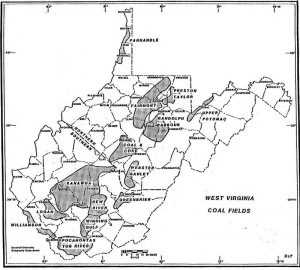
The Fairmont Coal Field is the name used to describe a coal-producing section of West Virginia that includes the following counties, in whole or in part: Monongalia, Marion, Preston, Taylor, Barbour, and Harrison counties.
Coal Seams of the Fairmont Coal Field
Mining in the Fairmont Coal Field has been confined to the seams appearing in the Monongahela, Conemaugh, and Allegheny series. The principal producing seams have been the Sewickley, Redstone, Pittsburgh, and Upper Freeport. The Pittsburg coal is found in Monongalia, Marion, Taylor, and Harrison counties and is mined extensively in all but Taylor County. The Pittsburgh is by far the most important seam in northern West Virginia and to the presence of this seam the region owes a large part of its industrial development.
Development of the Fairmont Coal Field
Coal from the Fairmont Coal Field was first mentioned in the Gazetteer of Virginia in 1835, the article reporting coal shipments to markets in Pittsburg and Cincinnati. Those shipments likely were made via flatboats on the Monongahela River.
Following the completion of the Baltimore & Ohio Railroad (B&O) to Fairmont in 1853, the O'Donnel mine, previously selling its products only to local markets, began shipping coal to markets in Baltimore via the railroad. In 1854, a mine was opened in Fairmont, near the B&O railroad station, by Francis H. Pierpont and James Otis Watson.




